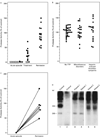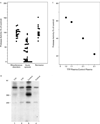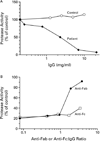Antibodies to von Willebrand factor-cleaving protease in acute thrombotic thrombocytopenic purpura
- PMID: 9828246
- PMCID: PMC3159001
- DOI: 10.1056/NEJM199811263392203
Antibodies to von Willebrand factor-cleaving protease in acute thrombotic thrombocytopenic purpura
Abstract
Background: Thrombotic thrombocytopenic purpura is a potentially fatal disease characterized by widespread platelet thrombi in the microcirculation. In the normal circulation, von Willebrand factor is cleaved by a plasma protease. We explored the hypothesis that a deficiency of this protease predisposes patients with thrombotic thrombocytopenic purpura to platelet thrombosis.
Methods: We studied the activity of von Willebrand factor-cleaving protease and sought inhibitors of this protease in plasma from patients with acute thrombotic thrombocytopenic purpura, patients with other diseases, and normal control subjects. We also investigated the effect of shear stress on the ristocetin cofactor activity of purified von Willebrand factor in the cryosupernatant fraction of the plasma samples.
Results: Thirty-nine samples of plasma from 37 patients with acute thrombotic thrombocytopenic purpura had severe deficiency of von Willebrand factor-cleaving protease. No deficiency was detected in 16 samples of plasma from patients with thrombotic thrombocytopenic purpura in remission or in 74 plasma samples from normal subjects, randomly selected hospitalized patients or outpatients, or patients with hemolysis, thrombocytopenia, or thrombosis from other causes. Inhibitory activity against the protease was detected in 26 of the 39 plasma samples (67 percent) obtained during the acute phase of the disease. The inhibitors were IgG antibodies. Shear stress increased the ristocetin cofactor activity of von Willebrand factor in the cryosupernatant of plasma samples obtained during the acute phase, but decreased the activity in cryosupernatant of plasma from normal subjects.
Conclusions: Inhibitory antibodies against von Willebrand factor-cleaving protease occur in patients with acute thrombotic thrombocytopenic purpura. A deficiency of this protease is likely to have a critical role in the pathogenesis of platelet thrombosis in this disease.
Figures






Comment in
-
Moschcowitz, multimers, and metalloprotease.N Engl J Med. 1998 Nov 26;339(22):1629-31. doi: 10.1056/NEJM199811263392210. N Engl J Med. 1998. PMID: 9828253 No abstract available.
-
von Willebrand factor-cleaving protease in thrombotic thrombocytopenic purpura and the hemolytic-uremic syndrome.N Engl J Med. 1999 Apr 29;340(17):1368-9. N Engl J Med. 1999. PMID: 10223877 No abstract available.
Similar articles
-
von Willebrand factor-cleaving protease in thrombotic thrombocytopenic purpura and the hemolytic-uremic syndrome.N Engl J Med. 1998 Nov 26;339(22):1578-84. doi: 10.1056/NEJM199811263392202. N Engl J Med. 1998. PMID: 9828245
-
Aetiology and pathogenesis of thrombotic thrombocytopenic purpura and haemolytic uraemic syndrome: the role of von Willebrand factor-cleaving protease.Best Pract Res Clin Haematol. 2001 Jun;14(2):437-54. doi: 10.1053/beha.2001.0142. Best Pract Res Clin Haematol. 2001. PMID: 11686108 Review.
-
Immunotherapy for thrombotic thrombocytopenic purpura.Curr Opin Hematol. 2005 Sep;12(5):359-63. doi: 10.1097/01.moh.0000170534.33517.99. Curr Opin Hematol. 2005. PMID: 16093780 Review.
-
von Willebrand factor and thrombotic thrombocytopenic purpura.Curr Opin Hematol. 2000 Sep;7(5):278-83. doi: 10.1097/00062752-200009000-00004. Curr Opin Hematol. 2000. PMID: 10961577 Review.
-
Deficiency of ADAMTS13 in thrombotic thrombocytopenic purpura.Int J Hematol. 2002 Aug;76 Suppl 2:132-8. Int J Hematol. 2002. PMID: 12430913 Review.
Cited by
-
A Rare Case of Acquired Thrombotic Thrombocytopenic Purpura Triggered by Acute Pancreatitis.Cureus. 2020 Jun 6;12(6):e8477. doi: 10.7759/cureus.8477. Cureus. 2020. PMID: 32642381 Free PMC article.
-
Low ADAMTS-13 activity during hemorrhagic events with disseminated intravascular coagulation.Int J Hematol. 2013 Apr;97(4):511-9. doi: 10.1007/s12185-013-1308-x. Epub 2013 Mar 14. Int J Hematol. 2013. PMID: 23494361
-
ADAMTS13 and von Willebrand factor interactions.Curr Opin Hematol. 2015 Sep;22(5):452-9. doi: 10.1097/MOH.0000000000000169. Curr Opin Hematol. 2015. PMID: 26186678 Free PMC article.
-
Clinical factors and biomarkers predict outcome in patients with immune-mediated thrombotic thrombocytopenic purpura.Haematologica. 2019 Jan;104(1):166-175. doi: 10.3324/haematol.2018.198275. Epub 2018 Aug 31. Haematologica. 2019. PMID: 30171022 Free PMC article.
-
[Thrombotic thrombocytopenic purpura. Reduced activity of von Willebrand factor cleaving protease].Nervenarzt. 2004 Aug;75(8):785-9. doi: 10.1007/s00115-004-1682-y. Nervenarzt. 2004. PMID: 15034657 German.
References
-
- Moschcowitz E. Hyaline thrombosis of the terminal arterioles and capillaries: a hitherto undescribed disease. Proc N Y Pathol Soc. 1924;24:21–24.
-
- Baehr G, Klemperer P, Schifrin A. Acute febrile anemia and thrombocytopenic purpura with diffuse platelet thromboses of capillaries and arterioles. Trans Am Physicians. 1936;51:43–58.
-
- Rock GA, Shumak KH, Buskard NA, et al. Comparison of plasma exchange with plasma infusion in the treatment of thrombotic thrombocytopenic purpura. N Engl J Med. 1991;325:393–397. - PubMed
-
- Török TJ, Holman RC, Chorba TL. Increasing mortality from thrombotic thrombocytopenic purpura in the United States — analysis of national mortality data, 1968–1991. Am J Hematol. 1995;50:84–90. - PubMed
-
- Bell WR. Thrombotic thrombocytopenic purpura/hemolytic uremic syndrome relapse: frequency, pathogenesis, and meaning. Semin Hematol. 1997;34:134–139. - PubMed
MeSH terms
Substances
Grants and funding
LinkOut - more resources
Full Text Sources
Other Literature Sources
